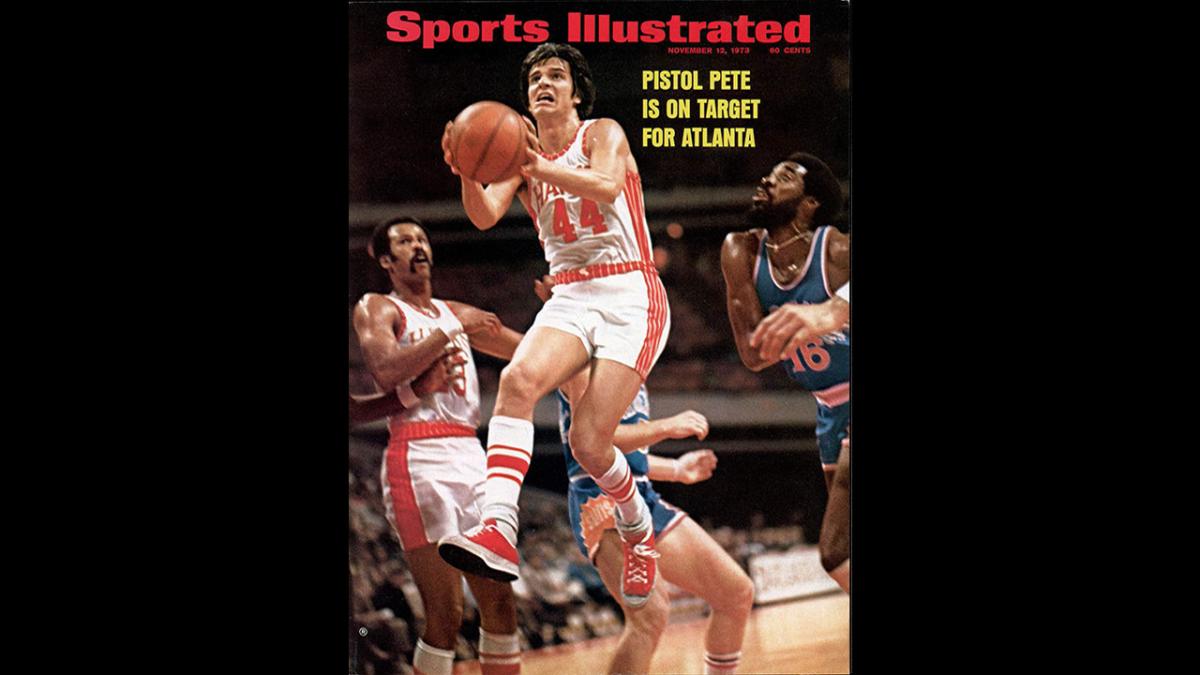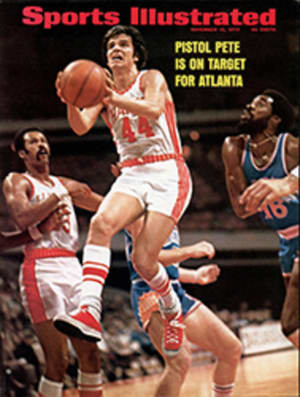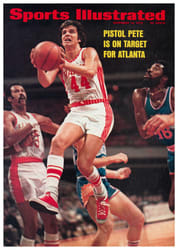
HE'S SHOOTING THE WORKS
As much as anything, their nicknames set forth the differences between them. The one called Pistol Pete is as hot and loud as a Saturday Night Special. His face is as angular and pointy as a Buntline Special and his skin as pale as a pearl handle. On a basketball floor he can be as fleeting and unpredictable as a ricocheting bullet and his jumper is often launched with all the grace of a man being gunned down from behind.
The other is named Sweet Lou, sweet as in cool jazz put down by a lightly plucked bass and the hushed swirling of brushes around a drumhead. His skin is the color of light coffee, his features regular and smooth, his temperament equable. His game is heavy on the sugar: there is a gentle rhythm to his constant motion on offense and a classic softness in his jump shot, of which there is none prettier.
Along with these dissimilarities, the two, Pete Maravich (see cover) and Lou Hudson, have a couple of things in common. They both wear the uniform of the Atlanta Hawks, and both were among the six NBA players who scored more than 2,000 points last season. Together they gave Atlanta a one-two punch matched only once before in the pros; in 1964-65 Elgin Baylor and Jerry West each topped 2,000 for the Lakers. And after the first dozen games of this season, Sweet Lou and Pistol Pete are picking up where they left off; Maravich has a 29.6-point average, Hudson a 23.8.
With a seven and five record at week's end, Atlanta has a 1½-game lead in the Central Division. The main reason for the Hawks' success is that their two stars glitter in decidedly different ways. Whenever a team has two exceptional scorers, the problem of who shall have the ball—and thus the opportunity to shoot it—can be nettlesome, particularly if the two have similar styles. If both are one-on-one artists who need to dribble for prolonged periods before they can score, their coach is apt to find them going one-on-one against each other to see who can rack up the most points. This tends to make their team susceptible to being racked up by any five guys who show up at the arena. For the past year Atlanta Coach Cotton Fitzsimmons has generally been able to avoid this kind of problem by leaving the ball with Maravich at guard and moving Hudson—twice an All-Star as a backcourt man and thrice as a forward—into the frontcourt. There he is free to do what he does best: move without the ball to get free for open shots. On the fast-breaking Hawks, that often means using his extraordinary quickness to fill an outside lane on a dash downcourt. But in pattern situations, Hudson must slog through the enervating business of cutting, dragging his man through picks and fighting defensive switches while his teammates enjoy the good feel of leather in their palms and the bulk of the referees' protection.
This state of affairs would be understandably irksome to Hudson if Maravich was off with the ball firing at will, as he did at LSU when he scored 3,667 points by attemping 38 field goals per game, or throwing ill-conceived passes into the loges, as he did during his first pro season. Not that the Pistol has become shy about shooting. Indeed, he is the NBA's leading scorer, but his .479 field-goal percentage, far higher than in previous years, indicates he has improved his shot selection. And last season he began completing more of his passes. While Hudson and Maravich were busy becoming the league's best scoring combination, Pete and his backcourt partner Herm Gilliam became the NBA's top assists team. Maravich flipped 153 more scoring passes than in his previous best season and finished with a 6.9 assists average, sixth best in the NBA.
All those points and passes, plus a modest improvement in defense, have earned Maravich the recognition from his peers he did not get after his ballyhooed arrival in the NBA in 1970. Back then Maravich received only six votes in the players' balloting for Rookie of the Year. Last season the players voted him a starter in the All-Star Game and in March elected him to the 10-man All-NBA squad.
In Maravich's rookie year the perennially powerful Hawks, a veteran team with all black starters, did not take kindly to the brash young white parvenu with the $2 million contract. Some of Pete's old teammates—Hudson is the only Hawk remaining from the pre-Maravich era—blamed Maravich, claiming he was selfish and sloppy on the court, and gauche in his personal relations. Hudson prefers to blame management. "It wanted us to bend to Pete," he says. "That's backwards. When I was a rookie, I was treated like one and I was glad just to be there. In Pete's case they said we should be happy just to be able to play with him."
Time and trades eventually solved that problem, but then Maravich had others. At the start of his second season, mononucleosis knocked his weight down from 205 to 169. and his stamina to zero. It was midseason before he began playing effectively. Then one day early last year he found he could not close his right eye. That side of his face was paralyzed as a result of bell's palsy. Maravich slurred his words like a drunk, had to tape his eye shut to sleep and feared he would never play again. Doctors, who know neither the cause of nor the cure for the ailment, told him it could last from two weeks to two years. Fortunately the palsy subsided after three weeks.
Long before that, Maravich's prominent place in the consciousness of basketball fans had subsided as well. Clearly, he was good but, just as clearly, he was a disappointment. In fact, it was not until the waning months of last season that he regained some of his old luster.
The current Pistol Pete is an improved model. Rarely does he drive at breakneck speed into the corner or wildly fling the ball up from midcourt. He usually concentrates on what his team is trying to achieve. Some of the original Maravich remains, but he does his between-the-legs, behind-the-back and over-the-shoulder passing and dribbling so fluidly that, along with his phenomenal quickness, they are now taken for granted. Still, in the last year he has proved that there are two things he does superlatively, perhaps better than anyone alive: handle the ball and shoot on the move.
"I was criticized for everything I did when I came into the league," Maravich says. "I believe if people keep criticizing enough, you'll finally do something that'll justify their criticism. I admit I made mistakes, but the mistakes were blown out of proportion because that's what everyone was looking for. They kept harping, 'Why do you dribble into traffic?' I enjoy going into traffic; that's my game. I can create that way. That's what me and a lot of young guys are into—revolutionizing basketball. The two-handed set shot used to be a big thing, but nobody's seen anyone take one in five years. We're working on things like passing and dribbling now. Take the chest pass. Five years from now you may never see another one of them."
While Maravich is off trying to foment revolutions, Hudson remains the quiet purist, a man so well versed in his art that before he returns to the floor after releasing an errant jumper he can tell why the shot failed to go in. While praising his defense, many pros consider his shooting technique the best there is. When he jumps, his body goes straight up with none of the sideward drift that throws lesser shooters off. His right elbow is tucked close to his side and the ball rests high on his fingertips. Over the last five seasons only five NBA players have averaged more than 20 points every year. Hudson is one of them; West, John Havlicek, Dave Bing and Elvin Hayes are the others and none have a shooting percentage to match Lou's .491 for his seven seasons. Yet he is a star without cachet, a man admired within his profession but rarely noticed outside it.
"I've always played with guards who controlled the ball," he says. "Archie Clark and I were together at Minnesota. When I came with the Hawks we had Lenny Wilkens and later Mahdi Abdul-Rahman and now Pete. All you can do is try to get open because that's the only way they'll notice you and throw you the ball, or at least you hope they do.
"I didn't intend to become a player like I am. I always wanted to be like Elgin Baylor. When I came to the Hawks, I tried his stuff. I'd shake my head one way and go the other, I'd shoot 15-foot hooks, sometimes I'd give a double pump on my shot. Richie Guerin was the coach then. He told me to cut it out, that that stuff was for the playground."
There is no flamboyance left in Hudson's game, but there is a lot of it in his home arena. The Hawks play in the spacious, year-old Omni in front of "crowds" that are scarcely omnipresent; they usually fill less than half the 16,818 seats. Over the last five years the Hawks' owners have tried five different general managers in the hope of getting reluctant Georgians, who stay home in the hope that Tuesday night football might miraculously appear on the tube, out to watch basketball. The latest candidate is 33-year-old Pat Williams, a promotional wizard fresh from crowd-building stints in Philadelphia and Chicago where he staged such halftime acts as Victor the Wrestling Bear and Little Arlene.
Williams, a mild-mannered, bespectacled, churchgoing sort, remembers Arlene with particular fondness because she was recommended to him in Philly by a player he had farmed out to Scranton of the Eastern League. Arlene, who weighed just 105 pounds, challenged five grown men to an eating contest and won by gobbling 77 hot dogs, 21 medium pizzas and 19 Cokes during a 76ers' game. She then told the public-address announcer to inform the audience that she would take on any five fans in a postgame oyster-eating bash at Bookbinders restaurant. Hoping to come up with another red-hot attraction, Williams called a meeting of the Hawks and asked for their ideas. The only one he received came from Maravich, who allowed as how he thought a lot of folks would show up if Williams screened Deep Throat every halftime.
Thrown back on his own resources, Williams staged a more mundane affair last week called Trick or Treat Night. Children in costume were allowed in free (when accompanied by a paying adult, to be sure) and given a treat. Public Address Announcer Pat Hogan appeared in a costume that made him look like a cross between Mae West and Mother Courage. Williams, disguised as Richard Nixon, threw up the opening pumpkin. The kids paraded at halftime for the judging of the best costumes, a contest won by Little Bo-Peep, a girl robot wearing what looked like a TV set over her head and a very small boy named Ronald Haygood who came as either Emmett Kelly or a drunken bum. When asked who he was supposed to be, Ronald replied, "I don't know. My daddy didn't tell me."
The evening's other activities included a 122-101 Hawks' win over Phoenix in which Maravich got 31 points and Hudson 20. Early in the second quarter Pete and Lou scored a pair of archetypal baskets within 45 seconds of one another. First Maravich squared off against his man 22 feet from the basket. Dribbling the ball far out in front of him, he invited Clem Haskins to attempt a steal. When Haskins leaned down to reach for the ball, Maravich changed hands by bouncing the ball between his legs, hopped to his right and shot. As the ball nestled in the basket, Haskins was still groping at the floor like a man trying to pick up loose change.
Hudson then increased the Hawk lead to 16 points from almost the same spot. Starting at a point on the floor opposite where teammate Steve Bracey stood patiently dribbling, Hudson first jabbed quickly toward the top of the key and then swooped low along the baseline, disappearing from Bracey's view behind a crowd beneath the basket. An instant later he popped clear on Bracey's side of the floor, took a pass and, turning and firing in one motion, swished his shot.
Later in the week at Houston both Hudson, who finished with 21 points, and Maravich were suffering through dismal shooting nights as the Hawks entered the final period trailing by eight points. Then with three minutes remaining Pete began the most extraordinary offensive burst of a young season. He hit a layup and a foul shot for a three-point play, a 29-foot jumper, a 21-footer falling down, a 23-footer on an out-of-bounds play, a breakaway layup off a steal and a 20-foot jumper from the left baseline. With 0:46 to go, Rocket Mike Newlin took Maravich's head fake and left his feet. Pete ducked under Newlin, waited until he soared past to his right and then, carefully fingering the ball, tossed in a 17-footer to make the score 122-121 Hawks. Gilliam got the final three points to sew up a 125-123 victory. In the fourth quarter Maravich scored 17 points, hit eight of eight field-goal attempts and poured in 15 straight points for his team in 2:15. He ended the game with 30 points.
Most of that scoring came on the sort of wild, one-man rushes that are no longer characteristic of Maravich's play. "My game is still explosion," he explained in the locker room. "This was a time I knew there was no reason to hold back. I would've shot from 40 feet and it would've gone in because I had my game going." He may have calmed down some, but the man is still a pistol.

